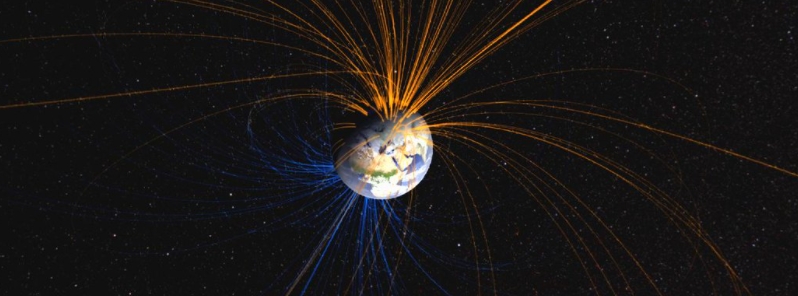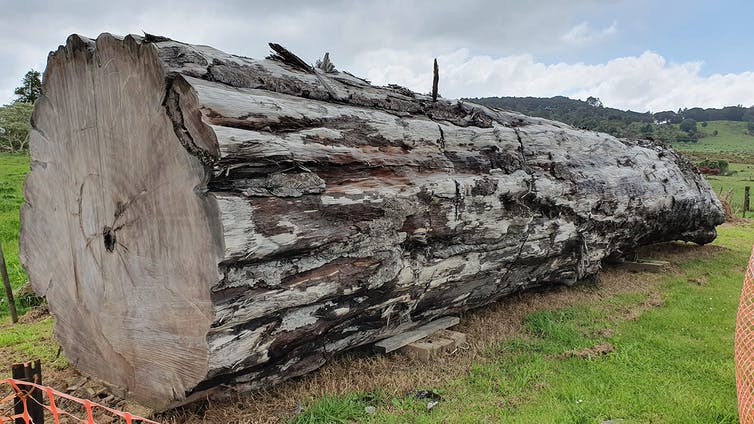Study: Earth’s magnetic reversal in combination with Grand Solar Minimum 42 000 years ago caused sudden, massive climate change

Around 42 000 years ago, the Earth's magnetic fields reversed, triggering sudden, major climate change, extinction events, and long-term changes in human behavior, a new study shows.
- Authors said they have precisely characterized the geomagnetic reversal and performed global chemistry-climate modeling and detailed radiocarbon dating of paleoenvironmental records to investigate impacts.
- They found that geomagnetic field minima 42 000 years ago, in combination with Grand Solar Minima, caused substantial changes in atmospheric ozone concentration and circulation, driving synchronous global climate shifts that caused major environmental changes, extinction events, and transformations in the archaeological record.
The magnetic north pole, where a compass needle points to, does not have a permanent location. Instead, it wobbles around close to the geographic north pole, the point around which the Earth spins due to movements within the Earth's core.
For reasons that are yet to be understood, magnetic pole movements can be more extreme than a wobble at times. One of the most dramatic movements — the Laschmps Excursion, took place around 42 000 years ago.
To study what happened during that time, the scientists analyzed ancient New Zealand kauri trees that had been preserved in peat bogs for more than 40 000 years.
Using the yearly growth rings, the researchers were able to produce a detailed timescale of how the Earth's atmosphere changed over this time. The trees revealed a prolonged spike in the radiocarbon levels in the atmosphere caused by the collapse of the magnetic fields as the poles switched.
"The kauri trees are like the Rosetta Stone, helping us tie together records of environmental change in caves, ice cores, and peat bogs around the world," said lead author Alan Cooper.

An ancient kauri tree log from Ngāwhā, New Zealand. Image credit: Nelson Parker
Using the new timescale, the authors were able to show that tropical Pacific rain belts and the Southern Ocean westerly winds suddenly shifted at the same time, bringing dry conditions to areas like Australia, during the same time as a range of megafauna and giant wombats went extinct.
Further north, the Laurentide Ice Sheet rapidly grew across the eastern U.S. and Canada, while the Neanderthals in Europe went into extinction.
The shifts may have caused synchronous global climate and environmental changes observed in other climate records that happened around 42 000 years ago.
The discovery that geomagnetic field fluctuations can impact atmospheric temperature and circulation on a worldwide scale may provide a model for understanding sudden and anomalous paleoenvironmental shifts, said the authors.
Reference
"A global environmental crisis 42,000 years ago" – Cooper, A. et al. – Science – DOI: 10.1126/science.abb8677
Abstract
Geological archives record multiple reversals of Earth’s magnetic poles, but the global impacts of these events, if any, remain unclear. Uncertain radiocarbon calibration has limited investigation of the potential effects of the last major magnetic inversion, known as the Laschamps Excursion [41 to 42 thousand years ago (ka)]. We use ancient New Zealand kauri trees (Agathis australis) to develop a detailed record of atmospheric radiocarbon levels across the Laschamps Excursion. We precisely characterize the geomagnetic reversal and perform global chemistry-climate modeling and detailed radiocarbon dating of paleoenvironmental records to investigate impacts. We find that geomagnetic field minima ~42 ka, in combination with Grand Solar Minima, caused substantial changes in atmospheric ozone concentration and circulation, driving synchronous global climate shifts that caused major environmental changes, extinction events, and transformations in the archaeological record.
Featured image credit: NASA/Goddard

More like 12,500 years ago, not 42,000.
If you are planning to be living past 2040 ,,worry,get your cave…etc..otherwise forget about…except, moving toward the equator will be a good idea
“What we found is, that the reversals had caused pronounced climate change, which was a huge surprise.” Is this guy serious?!?! It stands to REASON, that it WOULD! I wish that I could say one non-word word, to this guys face…..”DUH!!!!!!”. And these ‘mainstream so-called scientists’ wonder why it is that we do NOT trust them?!
How is this article relevant to today?
We’re experiencing these exact same conditions today and the magnetosphere has become exponentially weaker since 1859 (Carrington Event). A weak magnetosphere allows more cosmic radiation to penetrate, primarily through the North Pole; part of why our ozone is continually depleted as the ions that make their way through steal electrons from the O3 as it makes its way through. This will also cause heating of the waters at those latitudes, which melts the ice in the water, which injects a considerable amount of freshwater into the oceans, which then desalinates them. Ocean water traps heat better than fresh water, so as the oceans desalinate, it causes the currents to slow which slows the transfer of heat around the globe.
Long story short, expect a cold future for the next few decades, possible longer, at the very least. There are other potential issues, such as CME’s taking down our electrical grid and satellites, since our magnetosphere is less able to defend against the geomagnetic induction but for now, I’d just worry about the cold… 😉
Matt, thank you. That’s the best explanation in layman terms I’ve heard about what’s going on. Excellent.
well said. For the reasons you stated, I have always thought that to be the cause of global warming and cooling. Been going on for 100,000’s of years. Man effects it very little.
Climate change comes with the periodic excursions of earth’s magnetic field. The most up to date material available on this topic is from Ben Davidson at suspicious0bservers.com The Leschamps event is one of many and the time scale seems to be closer to every 12,000 years. I recommend some of the catastrophe videos Ben has available at his website and YouTube….(but don’t bother with his political opinions..IMHO)
that was said a story of my grandmas when they talk about majir volcanic eruotion of taal and mt makiling and near time will come that philippines will have rain of ice or snow.40yrs ago this is sometimes their chit chat topic and it came from their grandma of 1800s.and our place will be in water the safest is mt makulot tophill.at the end this place is sea.at teen i got the idea its pole shifting.i watch discovery history channels ideas bout that .so now with this hapenning im following later i found the watchmen earth and science it gives me now the idea of how its gonna happen.just following point is when will the major catastrophy will take its time.thanks forthe info
Thank you, Julie. But you are looking back through a dense fog of variables.
Radiocarbon dating is infused with uniformitarianism assumptions. How can you cite radiocarbon dating for catastrophic events? This opens up an Alice in Wonderland world of possibilities. Either catastrophism is false or the C02 levels are completely meaningless. You cannot have it both ways. See “Radiocarbon Dating is Infused with Uniformitarian Assumptions” at https://amallulla.org/time/#Radiocarbon_Dating_is_Infused_with_Uniformitarian_Assumptions.
42,000 years ago also disrespects everything we are told about the duration of major catastrophic cycles by the ancients in both the Yuga calendar and the Maya Long Count. 2 x 24,000 = 48,000 years ago is the least furthest back you can go for an extinction-level event such as you are contemplating. That would be the end of the Third World by my (2160 orbits of Jupiter count per Maya Long Count) reckoning.
Jamal Shrair “earth scientist” reveals the truth. He is a visiting intelligence. The time it takes the Solar System to travel its maximum distance away from the galactic plane is what is driving everything. Interesting. The arms are alive! Imagine that!
Remember: CO² is not the cause of climate change, but solar activity and cosmic rays with a changed magnetic field
Surprise, surprise! Institutional earth scientists were telling us all the times before that the reversal of earth’s magnetic field takes millions of years, but, now they are saying that earth reversed its magnetic field 42,000 years go. However, mainstream earth scientists and solar physicists do not know the reason, why the Sun and the earth change their magnetic fields in the first place. Thus, if they do not know the reason that causes the earth to change its magnetic field, then how can they know the time scale? Yes, the changes of earth’s magnetic field is always accompanied by huge earth changes, including massive volcanic eruption and huge earthquakes in the final phase of the reversal, but the time scale of the changes of earth’s magnetic field is much shorter than 42,000.
You are right. Every 12,000 years the magnetic field momentarily flip as the Earth crests the Galactic Current Sheet. See Suspicious Observers channel on YT.
If the Earth’s magnetic fields reversed then could the EU and Biden fix it by outlawing combustion engines and fossil fuels? Perhaps the 3rd year of a “two week lockdown to flatten the curve” would work.
NO, it would not stop the reversal as it has NOTHING to do with it.